
Watch online, learn more about eyes, and do your own dissection.
- Subject:
- Biology
- Science
- Material Type:
- Activity/Lab
- Lesson
- Author:
- Exploratorium
- Date Added:
- 09/28/2018

Watch online, learn more about eyes, and do your own dissection.
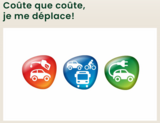
L’automobile est omniprésente dans notre quotidien depuis plus d’un siècle. Cette situation a toutefois un cout financier méconnu ainsi que d’importants impacts sur notre environnement.
Cette situation d’apprentissage permet aux jeunes de niveau secondaire de comparer les couts d’achat et d’utilisation de trois modes de transport, puis de prendre une décision « fictive » quant à leur choix de mode de déplacement.
Niveau scolaire
1er cycle du secondaire, 2e année

Students learn about the physical force of linear momentum movement in a straight line by investigating collisions. They learn an equation that engineers use to describe momentum. Students also investigate the psychological phenomenon of momentum; they see how the "big mo" of the bandwagon effect contributes to the development of fads and manias, and how modern technology and mass media accelerate and intensify the effect.

Starting February 22nd, Carrie Anne Philbin will be hosting Crash Course Computer Science! In this series, we're going to trace the origins of our modern computers, take a closer look at the ideas that gave us our current hardware and software, discuss how and why our smart devices just keep getting smarter, and even look towards the future! Computers fill a crucial role in the function of our society, and it's our hope that over the course of this series you will gain a better understanding of how far computers have taken us and how far they may carry us into the future.

In our first episode of Crash Course Engineering, Shini explains what engineering is, and gives a brief overview of its four main branches (civil, mechanical, electrical, and chemical) as well as a look at some of the other fields of engineering.

For as long as Hank has hosted Crash Course, he's wanted to host a series about the history of science. We've been asking big questions for a really long time and we've all wanted to explore how we've sought to answer those questions through the centuries. Questions like, "What is stuff?" and "Where are we?" have inspired people all over the world to investigate. So lets dive in and see how we, as a people, have tried to figure this stuff out.
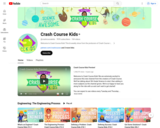
Crash Course Kids combines the same engaging lecture-style content delivery with animated graphics that focus on grade school science.
Topics include Earth Science, Physical Science, Biology, Geography, Engineering, and Astronomy.
These videos are amazing!

Students will explore Newton's laws of motion through a variety of activities, including an investigation that involves collisions.

Students will use Sphero 2.0 to impart a collision to study force, motion, and momentum in physical systems.
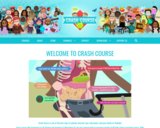
You can learn pretty much anything with these videos!
Science, History, Language Arts, & Study Skills, Games & More!

In this lesson, students find their location on a map using Latitude and Longitudinal coordinates. They determine where they should go to be rescued and how best to get there.
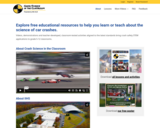
"Sponsored by the the Insurance Institute for Highway Safety, this resource provides free educational resources to help you learn or teach about the science of car crashes. Videos, demonstrations and teacher-developed, classroom-tested activities aligned to the latest standards bring crash safety STEM applications to grade 5-12 classrooms." MIT
Start by watching the "about" video. Follow "How it Works"
You can select Lessons on the top menu or more videos.
VIEW, DO, EXPLORE, UTILIZE

This is an activity about impact craters. Learners will experiment to create impact craters and examine the associated features. Then they observe images of lunar craters and explore how the mass, shape, velocity, and angle of impactors affects the size and shape of the crater. This activity is part of Explore! To the Moon and Beyond! - a resource developed specifically for use in libraries.
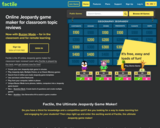
"Factile is the #1 Jeopardy-style classroom quiz review game! Learn why Factile is played by the best and get started now for free!
Create your own game in minutes
Search from thousands of premade game templates
Play Jeopardy-style, Multiple Choice, or as Classic Memory games
Use and share online flashcards
Play from your computer, tablet or phone
Users “buzz-in” for a fun and engaging classroom experience
New – Remote / Distance learning, including Remote Buzzer Mode"

You are preparing your family’s emergency kits in case there is a need to leave your home quickly, or stay in your home without electricity or water. You need to be able to create an emergency supply kit that includes a lightweight water filtration device that is low cost. This will provide you with clean water regardless of your water source.
In this project, you will gain knowledge of natural disaster preparedness through the Red Cross Pillowcase project. You will research and experiment with the water cycle to learn how water is naturally filtered. You will then design and build a water filtration device that could filter water in an emergency situation.

Coloring sheets provited by NASA.

DNA. It's what makes you unique. Unless you have an identical twin, your DNA is different from that of every other person in the world. And that's what makes DNA fingerprinting possible. Experts can use DNA fingerprints for everything from determining a biological mother or father to identifying the suspect of a crime. What, then, is a DNA fingerprint and how is it made? Here, you'll find out by solving a mystery—a crime of sorts. First, you'll create a DNA fingerprint (we'll supply the lab and all necessary materials). Then you'll compare this DNA fingerprint to those of all seven suspects to nab the perpetrator. Ready? Let's get to work!

In this activity, students construct their own pinhole camera to observe the behavior of light.
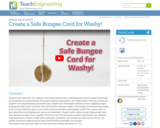
Students learn about the role engineers and mathematicians play in developing the perfect bungee cord length by simulating and experimenting with bungee jumping using washers and rubber bands. Working as if they are engineers for a (hypothetical) amusement park, students are challenged to develop a show-stopping bungee jumping ride that is safe. To do this, they must find the maximum length of the bungee cord that permits jumpers (such as brave Washy!) to get as close to the ground as possible without going "splat"! This requires them to learn about force and displacement and run an experiment. Student teams collect and plot displacement data and calculate the slope, linear equation of the line of best fit and spring constant using Hooke's law. Students make hypotheses, interpret scatter plots looking for correlations, and consider possible sources of error. An activity worksheet, pre/post quizzes and a PowerPoint® presentation are included.

"ThingLink is an award-winning education technology platform that makes it easy to augment images, videos, and virtual tours with additional information and links. Over 4 million teachers and students use ThingLink for creating accessible, visual learning experiences in the cloud."